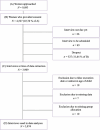Treatment and counselling preferences of postpartum women with and without symptoms of (childbirth-related) PTSD: findings of the cross-sectional study INVITE
- PMID: 39736602
- PMCID: PMC11686938
- DOI: 10.1186/s12884-024-07061-2
Treatment and counselling preferences of postpartum women with and without symptoms of (childbirth-related) PTSD: findings of the cross-sectional study INVITE
Abstract
Background: Post-traumatic stress disorder (PTSD) in the postpartum period is a prevalent yet under-researched mental health condition. To date, many women who suffer from postpartum PTSD remain unrecognized and untreated. To enhance the accessibility of help for these women, it is crucial to offer tailored treatment and counselling services that align with their needs. This study aimed to understand how support preferences differ between women with and without postpartum PTSD, considering the two subgroups of postpartum PTSD: childbirth-related PTSD (CB-PTSD) and general PTSD (gPTSD).
Methods: This study used data from the cross-sectional INVITE study, comprising telephone interviews with N = 3,874 women conducted six weeks to six months after childbirth. The City Birth Trauma Scale (City BiTS) was used to assess CB-PTSD, while the Primary Care Posttraumatic Stress Disorder Screen for DSM-5 (PC-PTSD-5) was used to assess gPTSD. Service preferences and preferred modes of service provision were measured with self-developed questionnaires. Analyses of variance were used to identify differences between groups.
Results: The support services (family-)midwives and family, friends, or colleagues and the service provision mode as in person communication were preferred most by women across groups. The analyses revealed that women with CB-PTSD had lower overall preferences for services compared to women without postpartum PTSD. Women with CB-PTSD also showed less preference for psychotherapeutic services (e.g. outpatient treatment, inpatient clinics) compared to women without postpartum PTSD. Regarding modes of service provision, women with gPTSD had a higher preference for all service modes compared to women with CB-PTSD and those without postpartum PTSD, with a stronger preference for both direct (e.g. in person, video conference) and delayed communication (e.g. chat, e-mail).
Conclusion: This study was the first to explore the support preferences of women experiencing symptoms of postpartum PTSD. Findings suggest that women differ in their preferences, contingent upon the subgroup of postpartum PTSD. According to women's overall preferences, the expansion and further training of (family-)midwife services is recommended. By tailoring support services accordingly to women's preferences, it may be possible to bridge the treatment gap for postpartum PTSD and to improve the well-being of affected women and their families.
Keywords: Childbirth-related PTSD; Help-Seeking; INVITE study; PTSD; Postpartum; Preferences; Service provision mode; Treatment and counselling services.
© 2024. The Author(s).
Conflict of interest statement
Declarations. Ethics approval and consent to participate: The INVITE study was conducted in accordance with the guidelines of the Declaration of Helsinki and approved by the Ethics Committee of the Technische Universität Dresden (No: EK 139042016). All participants provided written informed consent to participate in the study. Consent for publication: Not applicable. Competing interests: The authors declare no competing interests.
Figures



Similar articles
-
Service preferences among postpartum women (non-)affected by different types of intimate partner violence: insights from the cross-sectional study INVITE.BMC Public Health. 2025 Jan 2;25(1):2. doi: 10.1186/s12889-024-20921-y. BMC Public Health. 2025. PMID: 39748350 Free PMC article.
-
A diagnostic questionnaire for childbirth related posttraumatic stress disorder: a validation study.Am J Obstet Gynecol. 2024 Jul;231(1):134.e1-134.e13. doi: 10.1016/j.ajog.2023.11.1229. Epub 2023 Nov 21. Am J Obstet Gynecol. 2024. PMID: 37981091 Free PMC article.
-
Trait anxiety and unplanned delivery mode enhance the risk for childbirth-related post-traumatic stress disorder symptoms in women with and without risk of preterm birth: A multi sample path analysis.PLoS One. 2021 Aug 31;16(8):e0256681. doi: 10.1371/journal.pone.0256681. eCollection 2021. PLoS One. 2021. PMID: 34464408 Free PMC article.
-
Childbirth-related posttraumatic stress disorder: definition, risk factors, pathophysiology, diagnosis, prevention, and treatment.Am J Obstet Gynecol. 2024 Mar;230(3S):S1116-S1127. doi: 10.1016/j.ajog.2023.09.089. Epub 2024 Jan 9. Am J Obstet Gynecol. 2024. PMID: 38233316 Review.
-
Effect of Previous Posttraumatic Stress in the Perinatal Period.J Obstet Gynecol Neonatal Nurs. 2017 Nov-Dec;46(6):912-922. doi: 10.1016/j.jogn.2017.04.136. Epub 2017 Jun 28. J Obstet Gynecol Neonatal Nurs. 2017. PMID: 28667832 Review.
References
-
- Dennis C-L, Falah-Hassani K, Shiri R. Prevalence of antenatal and postnatal anxiety: Systematic review and meta-analysis. Br J Psychiatry. 2017. 10.1192/bjp.bp.116.187179. - PubMed
-
- Falah-Hassani K, Shiri R, Dennis C-L. The prevalence of antenatal and postnatal co-morbid anxiety and depression: a meta-analysis. Psychol Med. 2017. 10.1017/S0033291717000617. - PubMed
-
- McKenzie-McHarg K, Ayers S, Ford E, Horsch A, Jomeen J, Sawyer A, et al. Post-traumatic stress disorder following childbirth: An update of current issues and recommendations for future research. J Reprod Infant Psychol. 2015. 10.1080/02646838.2015.1031646.
MeSH terms
LinkOut - more resources
Full Text Sources
Medical
Miscellaneous

